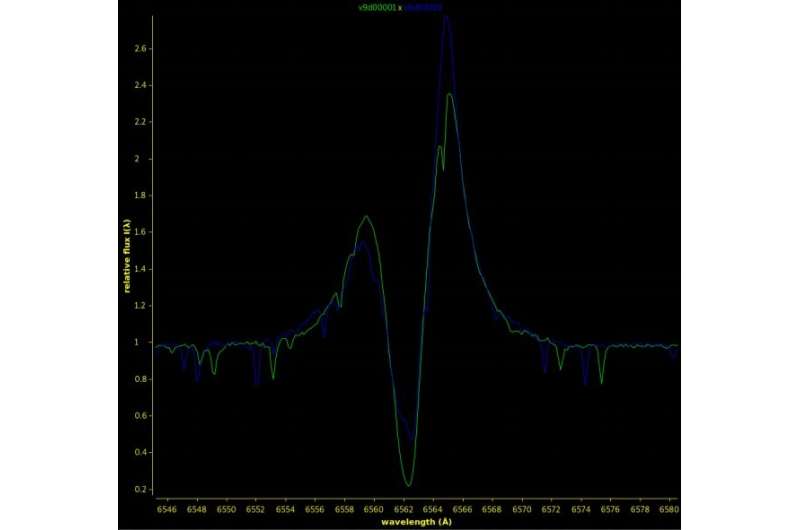June 1, 2020 report
Study investigates the nature of binary system 7 Vulpeculae

An international team of astronomers has conducted spectroscopic and photometric observations of a binary star known as 7 Vulpeculae. The new study, described in a paper published May 22 on arXiv.org, discloses more information about the properties of 7 Vulpeculae, shedding more light on the nature of this system.
The majority of binaries to date have been detected by Doppler shifts in their spectral lines, hence these systems are called "spectroscopic binaries." In such binaries, which usually have very high orbital velocity, the two stars are often very close, and may, in fact, exchange material due to tidal interactions.
Located some 940 light years away in the constellation of Vulpecula, 7 Vulpeculae (or 7 Vul for short) is a spectroscopic binary consisting of a visible Be star of spectral type B5 and an unknown companion. The system has an orbital period of about 69.3 days, orbital eccentricity of 0.16, and the primary star is known to have a rapid rotation rate with a projected rotational velocity of approximately 300 km/s.
Recently, a group of astronomers led by Petr Harmanec of Charles University in Prague, Czech Republic, took a closer look at 7 Vul. They carried out spectroscopic observations of the binary using the Ondřejov Observatory and the Dominion Astrophysical Observatory (DAO). The study, completed by various archival photometric data, was aimed at investigating the properties of the Be star and its mysterious companion.
First of all, the study by Harmanec's team confirmed the binary nature of 7 Vul and low mass of the secondary star suggested by previous observations. The new data also allowed the astronomers to put more constraints on the orbit of the system. It was found that the orbital period of 7 Vul is approximately 69.42 days, but the orbit's eccentricity is lower than previously thought, - 0.11.
Furthermore, the observations uncovered long-term spectral variations of the system's primary star and rapid light changes of the binary with a period of about 0.56 days. The researchers noted that the period of these light changes is comparable to the rotational period of the primary star, however, this phenomenon needs more detailed investigation in order to disentangle its nature.
When it comes to the properties of the companion star, the astronomers assume that it is a hot subdwarf with a mass of around 0.6 solar masses. They disfavor the hypothesis that it could be a cool Roche-lobe-filling object or a normal star of a late spectral class. According to the authors of the paper, the primary star would most likely be some six times more massive and four times larger than the sun, with an effective temperature of around 15,500 K.
Summing up the results, the astronomers note that if the companion is really a hot subdwarf, this would make 7 Vul an interesting rare system. This is due to the fact that no binary consisting of a B5 primary and hot subdwarf companion has been identified to date.
More information: A new study of the spectroscopic binary 7 Vul with a Be star primary, arXiv:2005.11089 [astro-ph.SR] arxiv.org/abs/2005.11089
© 2020 Science X Network





















